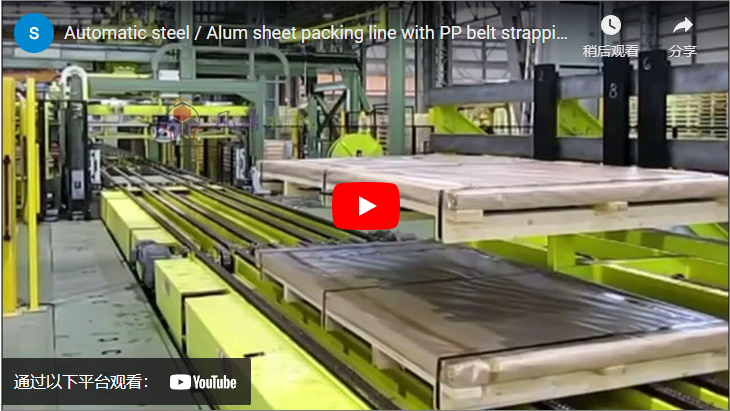Enhancing Metal Sheet Logistics: The Automated Steel & Aluminum Packing Line with PP Strapping and Palletizing
Modern metal processing and distribution demand efficiency, safety, and precision, particularly when handling large steel and aluminum sheets. Manual or semi-automated processes often introduce bottlenecks, increase labor costs, and pose significant safety risks. Addressing these challenges, the fully automatic steel/aluminum sheet packing line integrating Polypropylene (PP) belt strapping and robotic pallet stacking represents a significant advancement in material handling automation. This sophisticated system is engineered to streamline the entire end-of-line packaging process, from sheet infeed to final palletized stack ready for dispatch.
Technological Integration for Optimal Performance
This automated packing line is more than just a machine; it's an integrated system designed for high-throughput environments. Key technological components include:
- Automated Infeed Conveyors: Precision-controlled conveyors ensure smooth and accurate positioning of sheets entering the packaging cycle. Sensor technology detects sheet presence and dimensions, feeding data to the central PLC.
- PP Strapping Units: Utilizing durable and cost-effective Polypropylene strapping, these units apply consistent tension, securely bundling the sheets. Modern strapping heads often feature technology derived from patents focusing on tension control and seal efficiency (e.g., friction-weld sealing), ensuring bundle integrity during handling and transport. Research indicates PP strapping offers a favorable balance of strength, elongation, and recyclability compared to alternatives in many flat-sheet applications.
- Robotic Palletizing Module: A core component, typically featuring a multi-axis industrial robot or a dedicated gantry system. Advanced algorithms control the precise placement of strapped bundles onto pallets, optimizing stack patterns for stability and density. This aligns with industry trends highlighted in publications like Material Handling Management focusing on robotic automation for reducing ergonomic risks and improving pallet load quality.
- Integrated Control System: A Programmable Logic Controller (PLC) serves as the brain, orchestrating the sequence of operations. Paired with a Human-Machine Interface (HMI), it allows for easy monitoring, parameter adjustments (e.g., strap tension, stack height), and diagnostic feedback, enhancing operational control and minimizing downtime. Safety PLCs often manage integrated safety features according to standards like ISO 13849.
- Optional Enhancements: Systems can be further customized with modules for automatic protective film or paper application, edge protection placement, weighing stations, and labeling systems, providing a complete turnkey packaging solution.
Note: The parameters below provide a general overview. Specific configurations may vary based on application requirements. For detailed specifications matching your needs, please contact us directly.
Key Technical Specifications
- System Type: Fully Automated Packing and Palletizing Line
- Compatible Materials: Ferrous (Steel) and Non-Ferrous (Aluminum) Sheets
- Strapping Medium: Polypropylene (PP) Belt (Width and thickness customizable)
- Indicative Max Sheet Dimensions: Length: 6000mm; Width: 2000mm; Thickness: 150mm (Subject to configuration)
- Palletizing Capacity: Configurable, e.g., up to 30 sheets per pallet (dependent on sheet dimensions and weight)
- Typical Strapping Cycle Time: Approx. 45 seconds per strap application (Variable)
- Power Requirements: Example: 480V, 50Hz, Three Phase (Region specific)
- Approximate Footprint: Length: 12000mm; Width: 4500mm; Height: 4000mm (Layout dependent)
- Estimated Machine Weight: Approximately 6000kg (Varies with configuration)
- Control Architecture: PLC with Touchscreen HMI
- Safety Systems: Emergency stops, light curtains, safety interlocks on access doors, PLC-integrated safety functions
- Operational Uptime: Design target typically exceeds 98% with proper maintenance
- Maintenance Features: Preventative maintenance schedules via HMI, modular design for accessibility
Strategic Applications Across Industries
The implementation of automated sheet packing lines yields significant benefits in various industrial sectors:
1. Metal Sheet Manufacturing: Boosting Throughput and Enhancing Safety
In primary production facilities and service centers, handling large, heavy, and often sharp-edged metal sheets presents considerable operational challenges. Automation directly addresses these:
- Increased Productivity: Continuous, automated operation significantly outpaces manual methods, reducing cycle times and increasing overall plant throughput.
- Improved Workplace Safety: Eliminates strenuous manual lifting, carrying, and strapping tasks, drastically cutting the risk of musculoskeletal injuries and accidents, aligning with OSHA guidelines on ergonomic safety.
- Consistent Quality: Automated strapping ensures uniform tension and placement, while precise palletizing creates stable, secure loads, minimizing material damage during intra-plant movement and storage.
2. Automotive Industry: Optimizing the Supply Chain
The automotive sector relies heavily on Just-in-Time (JIT) delivery of steel and aluminum blanks and sheets.
- Supply Chain Reliability: Securely packaged and palletized sheets arrive ready for decoiling or feeding into stamping presses, preventing delays caused by damaged or poorly handled materials.
- Damage Prevention: Automated handling and secure strapping minimize surface scratches, dents, and edge damage, crucial for maintaining the Class-A surface quality often required for automotive panels.
- Logistics Efficiency: Standardized, stable pallets improve truck loading density and speed, contributing to leaner logistics operations.
3. Distribution Centers & Metal Service Centers: Maximizing Storage and Shipping Efficiency
For facilities managing large inventories and high volumes of metal sheets:
- Warehouse Optimization: Neatly stacked and uniform pallets allow for better utilization of vertical storage space and streamlined warehouse layouts. This density improvement is a key metric discussed in logistics journals.
- Faster Turnaround: Automated palletizing speeds up the preparation of orders for shipment, reducing truck waiting times and improving dock efficiency.
- Reduced Handling Costs: Minimizing manual touchpoints lowers labor costs associated with sorting, stacking, and preparing sheets for dispatch. Load stability also reduces the risk of costly damage during transit.
info@fhopepack.com


